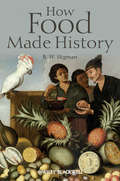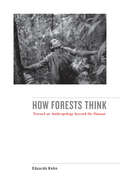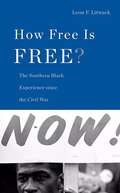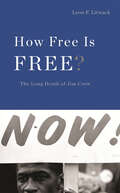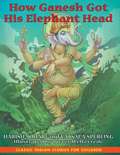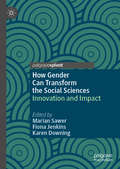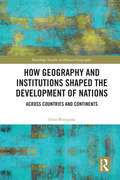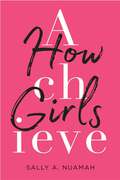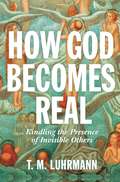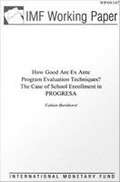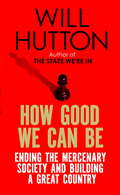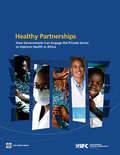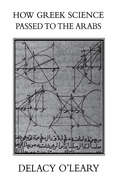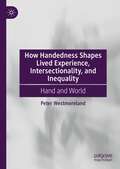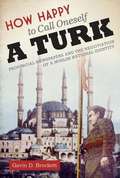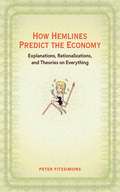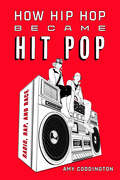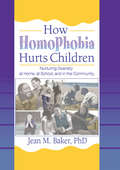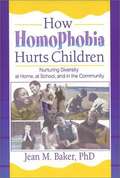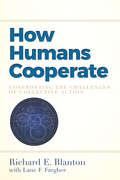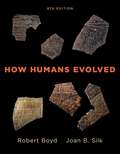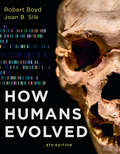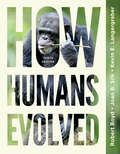- Table View
- List View
How Food Made History
by B. W. HigmanCovering 5,000 years of global history, How Food Made History traces the changing patterns of food production and consumption that have molded economic and social life and contributed fundamentally to the development of government and complex societies. Charts the changing technologies that have increased crop yields, enabled the industrial processing and preservation of food, and made transportation possible over great distances Considers social attitudes towards food, religious prohibitions, health and nutrition, and the politics of distribution Offers a fresh understanding of world history through the discussion of food
How Forests Think: Toward an Anthropology Beyond the Human
by Eduardo KohnCan forests think? Do dogs dream? In this astonishing book, Eduardo Kohn challenges the very foundations of anthropology, calling into question our central assumptions about what it means to be human—and thus distinct from all other life forms. Based on four years of fieldwork among the Runa of Ecuador’s Upper Amazon, Eduardo Kohn draws on his rich ethnography to explore how Amazonians interact with the many creatures that inhabit one of the world’s most complex ecosystems. Whether or not we recognize it, our anthropological tools hinge on those capacities that make us distinctly human. However, when we turn our ethnographic attention to how we relate to other kinds of beings, these tools (which have the effect of divorcing us from the rest of the world) break down. How Forests Think seizes on this breakdown as an opportunity. Avoiding reductionistic solutions, and without losing sight of how our lives and those of others are caught up in the moral webs we humans spin, this book skillfully fashions new kinds of conceptual tools from the strange and unexpected properties of the living world itself. In this groundbreaking work, Kohn takes anthropology in a new and exciting direction–one that offers a more capacious way to think about the world we share with other kinds of beings.
How Free Is Free? The Long Death of Jim Crow
by Leon F. LitwackIn 1985, a black veteran of the civil rights movement offered a bleak vision of a long and troubled struggle. For more than a century, black southerners learned to live with betrayed expectations, diminishing prospects, and devastated aspirations. Their odyssey includes some of the most appalling examples of terrorism, violence, and dehumanization in the history of this nation. But, as Leon Litwack graphically demonstrates, it is at the same time an odyssey of resilience and resistance defined by day-to-day acts of protest: the fight for justice poignantly recorded in the stories, songs, images, and movements of a people trying to be heard. For black men and women, the question is: how free is free? Despite two major efforts to reconstruct race relations, injustices remain. From the height of Jim Crow to the early twenty-first century, struggles over racism persist despite court decisions and legislation. Few indignities were more pronounced than the World War II denial of basic rights and privileges to those responding to the call to make the world safe for democratic values that they themselves did not enjoy. And even the civil rights movement promise to redeem America was frustrated by change that was often more symbolic than real. Although a painful history to confront, Litwack's book inspires as it probes the enduring story of racial inequality and the ongoing fight for freedom in black America with power and grace.
How Free Is Free?: The Long Death of Jim Crow (The Nathan I. Huggins lectures)
by Leon F. LitwackIn 1985, a black veteran of the civil rights movement offered a bleak vision of a long and troubled struggle. For more than a century, black southerners learned to live with betrayed expectations, diminishing prospects, and devastated aspirations. Their odyssey includes some of the most appalling examples of terrorism, violence, and dehumanization in the history of this nation. But, as Leon Litwack graphically demonstrates, it is at the same time an odyssey of resilience and resistance defined by day-to-day acts of protest: the fight for justice poignantly recorded in the stories, songs, images, and movements of a people trying to be heard.For black men and women, the question is: how free is free? Despite two major efforts to reconstruct race relations, injustices remain. From the height of Jim Crow to the early twenty-first century, struggles over racism persist despite court decisions and legislation. Few indignities were more pronounced than the World War II denial of basic rights and privileges to those responding to the call to make the world safe for democratic values—values that they themselves did not enjoy. And even the civil rights movement promise to redeem America was frustrated by change that was often more symbolic than real.Although a painful history to confront, Litwack’s book inspires as it probes the enduring story of racial inequality and the ongoing fight for freedom in black America with power and grace.
How Ganesh Got His Elephant Head
by Harish Johari Vatsala SperlingRelates adventures of Ganesh, the Hindu god of prosperity, and how he became the gods' gift to humanity.
How Gender Can Transform the Social Sciences: Innovation and Impact
by Karen Downing Marian Sawer Fiona JenkinsThis collection turns a spotlight on gender innovation in the social sciences. Eighteen short and accessibly written case studies show how feminist and gender perspectives bring new concepts, theories and policy solutions. Scholars across five disciplines– economics, history, philosophy, political science and sociology – demonstrate how paying attention to gender can sharpen the focus of the social sciences, improve the public policy they inform, and change the way we measure things. Gender innovation provokes rethinking at both the core and the margins of established disciplines, sometimes developing alternative fields of research that chart new territory. These case studies celebrate the contribution of feminist and gender scholars and span topics ranging from budgeting, electoral systems and security studies to the ethics of care, emotional labor and climate change.
How Geography and Institutions Shaped the Development of Nations: Across Countries and Continents (Routledge Studies in Human Geography)
by Irina BusyginaThis book provides a concise and informative introduction to how geography and institutions shaped the development of nations, showing that while the role of institutions for the development of nations is indisputable, the role of geographic factors remains underexplored and underestimated.Drawing on rich empirical material from the history and modernity of different continents and nations, How Geography and Institutions Shaped the Development of Nations: Across Countries and Continents seeks to show not only the importance of geographical explanations of development but also their extraordinary diversity. This book is divided into two parts. The first part examines the main contributions to the understanding of development under the influence of geographic and institutional factors, as well as state’s geographic attributes and borders as geographic institutions. The second part immerses the reader in empirical material, presenting various cases on different continents in different historical periods.This book is an essential read for researchers in a broad range of areas, including international organizations and practitioners involved accelerating national development. It will also be of interest to scholars and students in development studies and, more broadly, to geography, comparative politics, and regional studies.
How Girls Achieve
by Sally A. NuamahThis bold and necessary book points out a simple and overlooked truth: most schools never had girls in mind to begin with. That is why the world needs what Sally Nuamah calls feminist schools, deliberately designed to provide girls with achievement-oriented identities. And she shows why doing so would help all students, regardless of their gender.
How God Becomes Real: Kindling the Presence of Invisible Others
by T.M. LuhrmannThe hard work required to make God real, how it changes the people who do it, and why it helps explain the enduring power of faithHow do gods and spirits come to feel vividly real to people—as if they were standing right next to them? Humans tend to see supernatural agents everywhere, as the cognitive science of religion has shown. But it isn’t easy to maintain a sense that there are invisible spirits who care about you. In How God Becomes Real, acclaimed anthropologist and scholar of religion T. M. Luhrmann argues that people must work incredibly hard to make gods real and that this effort—by changing the people who do it and giving them the benefits they seek from invisible others—helps to explain the enduring power of faith.Drawing on ethnographic studies of evangelical Christians, pagans, magicians, Zoroastrians, Black Catholics, Santeria initiates, and newly orthodox Jews, Luhrmann notes that none of these people behave as if gods and spirits are simply there. Rather, these worshippers make strenuous efforts to create a world in which invisible others matter and can become intensely present and real. The faithful accomplish this through detailed stories, absorption, the cultivation of inner senses, belief in a porous mind, strong sensory experiences, prayer, and other practices. Along the way, Luhrmann shows why faith is harder than belief, why prayer is a metacognitive activity like therapy, why becoming religious is like getting engrossed in a book, and much more.A fascinating account of why religious practices are more powerful than religious beliefs, How God Becomes Real suggests that faith is resilient not because it provides intuitions about gods and spirits—but because it changes the faithful in profound ways.
How Good Are Ex Ante Program Evaluation Techniques? The Case of School Enrollment in PROGRESA
by Fabian BornhorstA report from the International Monetary Fund.
How Good We Can Be: Ending the Mercenary Society and Building a Great Country
by Will HuttonBritain is beset by a crisis of purpose. For a generation we have been told the route to universal well-being is to abandon the expense of justice and equity and so allow the judgments of the market to go unobstructed. What has been created is not an innovative, productive economy but instead a capitalism that extracts value rather than creates it, massive inequality, shrinking opportunity and a society organised to benefit the top 1%. The capacity to create new jobs and start-ups should not disguise that in the main the new world is one of throw away people working in throw away companies. The British are at a loss. The warnings of The State We're In have been amply justified. Will Hutton observes that the trends that so disturbed him twenty years ago have become more marked. Rather than take refuge in nativism and virulent euro-scepticism, Britain must recognize that its problems are largely made at home - and act to change them. With technological possibilities multiplying, a wholesale makeover of the state, business and the financial system is needed to seize the opportunities by being both fairer and more innovative. The aim must be to create an economy, society and democracy in which the mass of citizens flourish. In this compelling and vital new book Hutton spells out how.
How Good We Can Be: Ending the Mercenary Society and Building a Great Country
by Will HuttonBritain is beset by a crisis of purpose. For a generation we have been told the route to universal well-being is to abandon the expense of justice and equity and so allow the judgments of the market to go unobstructed. What has been created is not an innovative, productive economy but instead a capitalism that extracts value rather than creates it, massive inequality, shrinking opportunity and a society organised to benefit the top 1%. The capacity to create new jobs and start-ups should not disguise that in the main the new world is one of throw away people working in throw away companies. The British are at a loss. The warnings of The State We're In have been amply justified. Will Hutton observes that the trends that so disturbed him twenty years ago have become more marked. Rather than take refuge in nativism and virulent euro-scepticism, Britain must recognize that its problems are largely made at home - and act to change them. With technological possibilities multiplying, a wholesale makeover of the state, business and the financial system is needed to seize the opportunities by being both fairer and more innovative. The aim must be to create an economy, society and democracy in which the mass of citizens flourish. In this compelling and vital new book Hutton spells out how.
How Governments Can Engage the Private Sector to Improve Health in Africa
by World Bank StaffSince the private health sector is an important, and often dominant, provider of health services in Sub-Saharan Africa, it is the job of governments as the stewards of the health system to engage with it. Increasing the contributions that the existing private health sector is making to public health is an important, but often neglected, element of meeting the daunting health-related challenges facing African nations. This Report presents newly collected data on how and how effectively each country in the Africa region is engaging the respective private health sectors; and how the engagement compares across the region. While the approach taken by governments varies greatly between countries, there is much room for improvement in the Africa region overall to engage more effectively and room for exchange of ideas and good practices on how to do so. Improved solutions on the policy/regulatory side should be supported by effective organization of the private sector itself and by adjustments in donor programs that take the dynamics of the private health sector better into account.
How Greek Science Passed On To The Arabs
by O'LEARYFirst published in 2002. Routledge is an imprint of Taylor & Francis, an informa company.
How Green is Your Smartphone? (Digital Futures)
by Toby Miller Richard MaxwellEvery day we are inundated by propaganda that claims life will be better once we are connected to digital technology. Poverty, famine, and injustice will end, and the economy will be “green.” All anyone needs is the latest smartphone. In this succinct and lively book, Maxwell and Miller take a critical look at contemporary gadgets and the systems that connect them, shedding light on environmental risks. Contrary to widespread claims, consumer electronics and other digital technologies are made in ways that cause some of the worst environmental disasters of our time – conflict-minerals extraction, fatal and life-threatening occupational hazards, toxic pollution of ecosystems, rising energy consumption linked to increased carbon emissions, and e-waste. Nonetheless, a greener future is possible, in which technology meets its emancipatory and progressive potential. How Green is Your Smartphone? encourages us to look at our phones in a wholly new way, and is important reading for anyone concerned by the impact of everyday technologies on our environment.
How Handedness Shapes Lived Experience, Intersectionality, and Inequality: Hand and World
by Peter WestmorelandThis book delivers philosophy’s first sustained examination of handedness: being left-handed, right-handed, etc. It engages literature from phenomenology and continental philosophy, analytic philosophy, laterality studies, cognitive science and psychology, gender studies and feminist philosophy, sociology, political science, and more to provide a systematic accounting of the nature of handedness, its basis in lived experience, its effects on bodily performance, its role in varieties of inequality, and its part in oppression and liberation.As a radical asymmetry in the body, handedness plays a key role in human flourishing. It informs both personal bodily movement and social life, from handshakes and high fives to high tech tools made for one hand or the other. Moreover, with left-handers making up just 10% of the population, handedness presents a significant inequality in lived experience. To live and live well, we must understand handedness.
How Happy to Call Oneself a Turk
by Gavin D. BrockettThe modern nation-state of Turkey was established in 1923, but when and how did its citizens begin to identify themselves as Turks? Mustafa Kemal Ataturk, Turkey's founding president, is almost universally credited with creating a Turkish national identity through his revolutionary program to "secularize" the former heartland of the Ottoman Empire. Yet, despite Turkey's status as the lone secular state in the Muslim Middle East, religion remains a powerful force in Turkish society, and the country today is governed by a democratically elected political party with a distinctly religious (Islamist) orientation. In this history, Gavin D. Brockett takes a fresh look at the formation of Turkish national identity, focusing on the relationship between Islam and nationalism and the process through which a "religious national identity" emerged. Challenging the orthodoxy that Ataturk and the political elite imposed a sense of national identity from the top down, Brockett examines the social and political debates in provincial newspapers from around the country. He shows that the unprecedented expansion of print media in Turkey between 1945 and 1954, which followed the end of strict, single-party authoritarian government, created a forum in which ordinary people could inject popular religious identities into the new Turkish nationalism. Brockett makes a convincing case that it was this fruitful negotiation between secular nationalism and Islam--rather than the imposition of secularism alone--that created the modern Turkish national identity.
How Hemlines Predict the Economy: Explanations, Rationalizations, and Theories on Everything
by Peter FitzsimonsWhy does the dominant partner in any sexual relationship usually sleep on the side of the bed nearest the door? Is there a direct relationship between the length of hemlines and the state of the national economy? Are odd numbers evil? And why do drivers with hats drive twenty miles per hour slower than those without?These are the big questions of life, and it takes a brave man to tackle them. Author, broadcaster, and columnist Peter FitzSimons is the ideal guide to the weird world of the popular theory, the urban myth, and the land of "did you know...?" His offbeat, insightful, and painfully funny takes on our world will have readers laughing out loud and recounting every last anecdote to friends and family. FitzSimons' knack for witty and wise observations of everything from relationship phenomena to street traffic is sure to leave all American readers wondering why they haven't read him until now. A perfect gift for the man who has everything but answers.
How Hip Hop Became Hit Pop: Radio, Rap, and Race
by Amy CoddingtonA free ebook version of this title is available through Luminos, University of California Press's Open Access publishing program. Visit www.luminosoa.org to learn more.How Hip Hop Became Hit Pop examines the programming practices at commercial radio stations in the 1980s and early 1990s to uncover how the radio industry facilitated hip hop's introduction into the musical mainstream. Constructed primarily by the Top 40 radio format, the musical mainstream featured mostly white artists for mostly white audiences. With the introduction of hip hop to these programs, the radio industry was fundamentally altered, as stations struggled to incorporate the genre's diverse audience. At the same time, as artists negotiated expanding audiences and industry pressure to make songs fit within the confines of radio formats, the sound of hip hop changed. Drawing from archival research, Amy Coddington shows how the racial structuring of the radio industry influenced the way hip hop was sold to the American public, and how the genre's growing popularity transformed ideas about who constitutes the mainstream.
How Homophobia Hurts Children: Nurturing Diversity at Home, at School, and in the Community
by Jean M BakerHomophobia hurts kids. Explore ways to minimize that trauma!This book illustrates the ways that children growing up to be gay are harmed by homophobia before anyone, including themselves, even knows they are gay. This compelling and sympathetic volume describes many simple ways that these children can be helped to understand that they can grow up to lead normal lives, with hopes and dreams for their futures. How Homophobia Hurts Children: Nurturing Diversity at Home, at School, and in the Community brings home the voices of these children. They describe their experiences to show how they came to the frightening recognition that they are part of a group held in disregard by the rest of society, even sometimes by their own families.Dr. Jean M. Baker, the author of How Homophobia Hurts Children: Nurturing Diversity at Home, at School, and in the Community is a clinical psychologist and the mother of two gay sons. In this book she shares her experience as both psychologist and mother to show how the myths and fallacies about homosexuality have influenced parents, schools, churches, and lawmakers to send children the cruel message that if they are gay, they are not normal and will not be able to lead normal lives. In this unique volume you'll find: a chapter on identity development, following the Eriksonian model interviews with high school students who are self-identified as gay firsthand descriptions of the harassment and victimization of those perceived as gay in schools research on how victimization at school affects gay youths a discussion of the relatively new phenomenon of gay/straight alliances (gay support groups or clubs) a chapter on transgender identity with interviews with four transsexual persons who describe their personal childhood experiences and their transition processThe focus of How Homophobia Hurts Children: Nurturing Diversity at Home, at School, and in the Community, centering on the social and familial experiences of children who will grow up to be gay but have not yet come to that realization, is unique. But beyond that, this book also explains how homophobia affects the attitudes of non-gay children by leading them to believe that it is acceptable to mistreat homosexuals. Finally, specific suggestions are made for changes in parenting and changes in school/classroom practices that could help prevent the harm that is inflicted upon so many of our gay children. Everyone who comes in contact with children on their way to becoming gay/lesbian/bisexual/transgender adults needs to read this book!
How Homophobia Hurts Children: Nuturing Diversity at Home, at School, and in the Community (Haworth Gay & Lesbian Studies)
by Jean M. BakerHomophobia hurts kids. Explore ways to minimize that trauma!<P> This book illustrates the ways that children growing up to be gay are harmed by homophobia before anyone, including themselves, even knows they are gay. This compelling and sympathetic volume describes many simple ways that these children can be helped to understand that they can grow up to lead normal lives, with hopes and dreams for their futures. How Homophobia Hurts Children: Nurturing Diversity at Home, at School, and in the Community brings home the voices of these children. They describe their experiences to show how they came to the frightening recognition that they are part of a group held in disregard by the rest of society, even sometimes by their own families.<P> Dr. Jean M. Baker, the author of How Homophobia Hurts Children: Nurturing Diversity at Home, at School, and in the Community is a clinical psychologist and the mother of two gay sons. In this book she shares her experience as both psychologist and mother to show how the myths and fallacies about homosexuality have influenced parents, schools, churches, and lawmakers to send children the cruel message that if they are gay, they are not normal and will not be able to lead normal lives. <P> In this unique volume you'll find:<P> * a chapter on identity development, following the Eriksonian model<P> * interviews with high school students who are self-identified as gay<P> * firsthand descriptions of the harassment and victimization of those perceived as gay in schools<P> * research on how victimization at school affects gay youths<P> * a discussion of the relatively new phenomenon of gay/straight alliances (gay support groups or clubs)<P> * a chapter on transgender identity with interviews with four transsexual persons who describe their personal childhood experiences and their transition process<P> The focus of How Homophobia Hurts Children: Nurturing Diversity at Home, at School, and in the Community, centering on the social and familial experiences of children who will grow up to be gay but have not yet come to that realization, is unique. But beyond that, this book also explains how homophobia affects the attitudes of non-gay children by leading them to believe that it is acceptable to mistreat homosexuals. Finally, specific suggestions are made for changes in parenting and changes in school/classroom practices that could help prevent the harm that is inflicted upon so many of our gay children. Everyone who comes in contact with children on their way to becoming gay/lesbian/bisexual/transgender adults needs to read this book!
How Humans Cooperate: Confronting the Challenges of Collective Action
by Richard E. BlantonIn How Humans Cooperate, Richard E. Blanton and Lane F. Fargher take a new approach to investigating human cooperation, developed from the vantage point of an "anthropological imagination." Drawing on the discipline’s broad and holistic understanding of humans in biological, social, and cultural dimensions and across a wide range of temporal and cultural variation, the authors unite psychological and institutional approaches by demonstrating the interplay of institution building and cognitive abilities of the human brain. Blanton and Fargher develop an approach that is strongly empirical, historically deep, and more synthetic than other research designs, using findings from fields as diverse as neurobiology, primatology, ethnography, history, art history, and archaeology. While much current research on collective action pertains to local-scale cooperation, How Humans Cooperate puts existing theories to the test at larger scales in markets, states, and cities throughout the Old and New Worlds. This innovative book extends collective action theory beyond Western history and into a broadly cross-cultural dimension, places cooperation in the context of large and complex human societies, and demonstrates the interplay of collective action and aspects of human cognitive ability. By extending the scope and content of collective action theory, the authors find a fruitful new path to understanding human cooperation.
How Humans Evolved
by Robert Boyd Joan B. SilkThis book focuses on the processes that have shaped human evolution. As anthropologists, the authors are interested in the evolutionary history of their own species. Homo sapiens and the diversity of contemporary human societies. As evolutionary biologists, the authors study how evolution works to shape the natural world. In this book, they integrate these two perspectives and use current theoretical and empirical work in evolutionary theory, population genetics and behavioral ecology to interpret human evolutionary history. They describe the changes that have occurred as the human lineage has evolved and consider why these changes may have happened. By focusing on the processes that generate change, create adaptations and shape bodies and behavior, they try to give life to the creatures that left the bones and made the artifacts that paleontologists and archaeologists painstakingly excavate. The authors also pay serious attention to the role of evolution in shaping contemporary human behavior. The list of references for further reading at the end of each chapter provides a starting point for students who want to delve more deeply into the material covered in that chapter.
How Humans Evolved (Ninth Edition)
by Robert Boyd Joan B. SilkThe gold-standard text, with new cutting-edge genetic research How Humans Evolved has long been the #1 text for helping students understand the most exciting research in biological anthropology. In the Ninth Edition, new contributing author Kevin Langergraber makes the discipline’s newest frontier—ancient and contemporary DNA research—accessible and relevant to students. Further new coverage of important recent fossil discoveries, modern human behavior, and race ensure the text continues inspiring students to think critically about the key developments driving the field today. This purchase offers access to the digital ebook only.
How Humans Evolved (Tenth Edition)
by Robert Boyd Joan B. Silk Kevin LangergraberThe gold-standard introduction to biological anthropology. How Humans Evolved has long been the leading text for helping students understand the science of human evolution. With comprehensive, up-to-date coverage of human genetics, recent fossil discoveries, race, and modern human behavior, it is clear why the Tenth Edition remains, in primatologist Sarah Hrdy’s words, “the text of choice for teaching physical anthropology and human evolutionary biology.” New 3D models of select human and non-human primate crania and anatomy, as well as fossil crania of key hominins, invite students to explore specimens in a tactile way. This purchase offers access to the digital ebook only.
